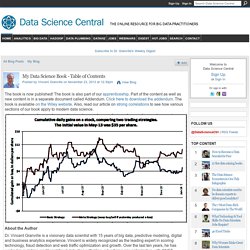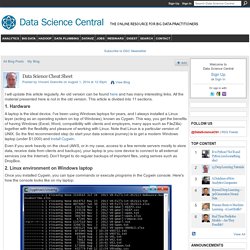

Swirl: Learn R, in R. Statistical Learning. About This Course This is an introductory-level course in supervised learning, with a focus on regression and classification methods.

The syllabus includes: linear and polynomial regression, logistic regression and linear discriminant analysis; cross-validation and the bootstrap, model selection and regularization methods (ridge and lasso); nonlinear models, splines and generalized additive models; tree-based methods, random forests and boosting; support-vector machines. Some unsupervised learning methods are discussed: principal components and clustering (k-means and hierarchical). This is not a math-heavy class, so we try and describe the methods without heavy reliance on formulas and complex mathematics. We focus on what we consider to be the important elements of modern data analysis.
The lectures cover all the material in An Introduction to Statistical Learning, with Applications in R by James, Witten, Hastie and Tibshirani (Springer, 2013). Course Staff Trevor Hastie Rob Tibshirani. Learn R. Upload mybringback.com mybringback Loading...

Working... Quick-R: Home Page. Why R is Hard to Learn. By Bob Muenchen R has a reputation of being hard to learn.

Some of that is due to the fact that it is radically different from other analytics software. Some is an unavoidable byproduct of its extreme power and flexibility. And, as with any software, some is due to design decisions that, in hindsight, could have been better. If you have experience with other analytics tools, you may at first find R very alien. Below is a list of complaints about R that I commonly hear from people taking my R workshops. Unhelpful Help R’s help files are often thorough and usually contain many working examples. Another confusing aspect to R’s help files stems from R’s ability to add new capabilities (called methods) to some functions as you load add-on packages.
So an R beginner has to learn much more than a SAS or SPSS beginner before he or she will find the help files very useful. Misleading Function or Parameter Names Another command that commonly confuses beginners is the simple “if” function. Code School - Try R. DataVisualization. An R Introduction to Statistics. The Data Science Toolkit - taking your first steps towards becoming a Data Scientist. When I stumbled upon the phrase "Data Scientist" 3 years ago, I immediately recognized it as my best prospect for a productive career.

How to start? What are the tools of the trade? This is the blog post I wish I could have read back then. Many of the things I list here didn't exist or were unstable until recently. I discovered the "predictive analytics" rabbit hole and started to read and watch whatever I could find on the subject. PostgreSQL MongoDB HBase Cassandra ElasticSearch Redis Tokyo Tyrant Chef/Puppet/Ansible Every aspiring "Big Data" worker should watch his interview. Which of these databases will I need for my DS career? A Flip Kromer quote driving my current project is "We need a Mechanical Turk that slides up the talent scale. " Visualizing data is the most glamorous of the DS skills, and most of us are dazzled with d3.js and feel love at first sight. Learning NodeJS (closures, promises..) dumps even more tools on the list and my learning curve is turning into a wall.
Wait! Our Data Science Apprenticeship is Now Live. Updated on 12/22/1014: Click here for updated application process.

Updated on 5/18/2014: Click here to check the most recent list of projects offered to candidates. Our textbook is now published, new data sets and new tutorials added, and the data science cheat sheet will soon be available in its final format. Our program is for practitioners interested in being mentored by Dr Granville. Participants work on real-life data science projects, to gain professional experience, knowledge and visibility in the data science community. So what does it mean for you and how to get started? First, we remind you that this is still a program for self-learners, presenting original, core, modern, applied, useful pioneering data science material not found in traditional programs.
How to get started? Read the steps required to complete the program (see below), and if you are still interested, proceed to step #1. The program in 7 steps Email us at vincentg@datasciencecentral to show your interest. That's it! My Data Science Book - Table of Contents. The book is now published!

The book is also part of our apprenticeship. Part of the content as well as new content is in a separate document called Addendum. Click here to download the addendum. The book is available on the Wiley website. Data Science Apprenticeship. Our Data Science Apprenticeship is Now Live. 20 short tutorials all data scientists should read (and practice) Data Science Cheat Sheet. I will update this article regularly.

An old version can be found here and has many interesting links. All the material presented here is not in the old version. This article is divided into 11 sections. 1. Hardware A laptop is the ideal device. Even if you work heavily on the cloud (AWS, or in my case, access to a few remote servers mostly to store data, receive data from clients and backups), your laptop is you core device to connect to all external services (via the Internet). 2. Once you installed Cygwin, you can type commands or execute programs in the Cygwin console. Data Science Apprenticeship. Awesome Data Science Repository. One Page R: A Survival Guide to Data Science with R.